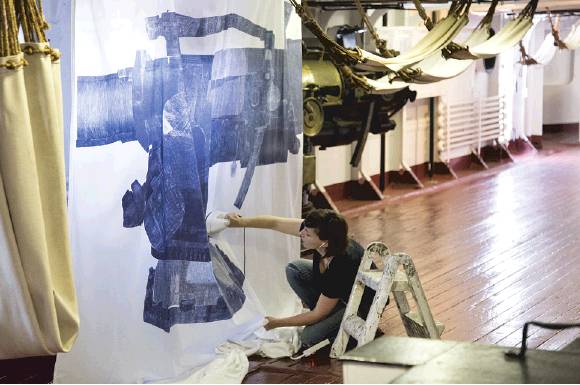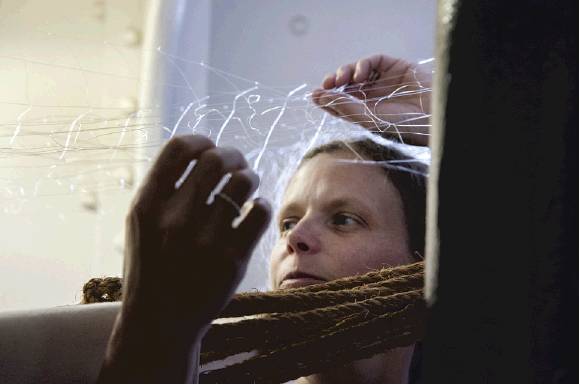Vessel of Art
Ghostly crewmen, crocheted rats, levitating monofilament hammocks — sculptors take over the cruiser Olympia for asite-specific installation.
By Samantha Melamed STAFF WRITERAfter more than a century afloat — first, in steadfast military service, then in dignified, if rusty, retirement on the Delaware River — the cruiser Olympia has been overtaken by a spell of delirium.
The officers’ washroom has become a mustache-themed fun house featuring every style and texture of facial hair. Ghostly crewmen flicker in the sick bay, lockets appear to float through a stateroom, and, in the sailors’ quarters, hammocks of almost invisible monofilament levitate like departing souls.
The ship, decommissioned in 1922, has been pressed into service as the Artship Olympia: a series of site-specific installations on the historic vessel, opening Friday night and on view through Oct. 2.
The exhibition, organized by the nonprofit Philadelphia Sculptors, deployed 17 artists to reinterpret spaces on the ship, from the galley to the sick bay to the captain’s office — and even the hull.
It is the organization’s maiden seafaring voyage, meant in part to help generate interest in a historic site with major funding needs ahead.
“The idea is to bring new attention to the ship and to bring a new audience of artists and art lovers,” Philadelphia Sculptors president Leslie Kaufman said.
The Olympia first launched in 1892, ahead of the Spanish-American War, and served as Adm. George Dewey’s flagship in the Battle of Manila Bay. The oldest steel warship still afloat, it came to rest in the Delaware River more than 60 years ago and at the Independence Seaport Museum in 1996. Given the expense of maintaining it, museum officials at various points considered sinking the ship or giving it over to a conservation group elsewhere in the country. In 2014, the museum announced it would continue to care for the ship; a fund-raising campaign for restoration and infrastructure that will cost an estimated $15 million to $20 million is in the planning stage.
Museum chief executive John Brady said art could be a way to connect the ship with the community. “Over the years, I don’t think enough has been done to popularize the ship, and this is a move in that direction,” he said. Besides, “maritime art is a genre that’s been around for centuries ... but we’re also quite willing to look forward.”
To that end, the vessel presents a storied backdrop for artists such as Matt Suib and Nadia Hironaka, who made two installations for Artship: a video projection for the hull that will be shown Friday night only, starting at dusk, and an installation inside an officer’s stateroom.
“When we’re working on a historic site, we’re responding to the history that’s represented at that site, but we’re doing it through a contemporary lens,” Suib said. In the case of the Olympia, “the lens we’re looking through is one of 120 years of American involvement in foreign wars, beginning with the Spanish-American War up to our present-day conflicts.”
The video projection shows war footage and quotes about the war. The installation they crafted is a “Pepper’s Ghost,” a primitive version of a hologram popular in the Olympia’s heyday, depicting floating lockets containing portraits of leaders and revolutionaries who were supported or undermined by the United States.
Because of the ship’s historic nature, all the installations had to be temporary — no drilling into the walls or altering them in any way.
Working within those parameters, some artists created subtle, small-scale interventions, while others turned parts of the ship into ambitious, immersive installations.
Quieter works include Joan Menapace’s crocheted rats, 30 of them altogether — the sailors’ constant companion made tame and even cute.
Jacintha Clark filled the captain’s office with delicately wrought porcelain replicas of navigation and communication equipment: sextants, charts, photographs, a Morse code machine.
And Sarah Kate Burgess filled the lockers in the sailors’ washroom with sculptures small enough to hold in the palm of your hand (but so menacing you wouldn’t want to). There’s a darning egg with a sharp needle protruding from it, for example, or a toothbrush with cat whiskers for bristles.
“These are objects I’m hypothesizing the crew could make on board the ship,” said Burgess, of South Kensington, as she arranged the works in their places Monday. The pieces reference pastimes and chores such as tattooing, embroidery, cooking, and cleaning. “They were on these very long journeys with no rest. I’m interested in how people can carve out a part of their life that is their own, even when they’re a cog in a large machine.”
Other works command a more ambitious scale.
In a crew sleeping area, Elizabeth Mackie, an installation artist from Frenchtown, N.J., was wrangling with issues metaphoric and technical. Her piece, She-Sea, a meditation on the mythology of the ocean as a feminine force, was taking the form of roiling waves of netting, overlaid with projections of dresses and hair and a Sirenlike audio track from Brooklyn sound artist Kaitlyn Paston.
“This space presented a lot of issues I hadn’t dealt with before,” Mackie said. “You can’t nail anything into the wall. We’re trying to figure out how to make projectors stay up in the air.”
Meanwhile, in the ship’s sick bay, Joanna Platt and Nathan Solomon were setting up their own surreal scene. A flotilla of cast-resin ships — a model of the Olympia and two other ships that were in the Battle of Manila Bay — appeared to float in a bathtub, illuminated by lasers and video. Behind that scene, the artists were installing glass screens for magic lantern projections of images of sailors they had found in the museum’s archive.
“We were interested in the sick bay as a place where you confront your mortality,” Platt said.
In this work, she added, “the challenge is trying to find a way that wasn’t just representing the history, but also adding a personal, human element.” smelamed@phillynews.com
215-854-5053
@samanthamelamed



